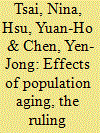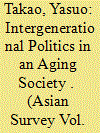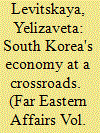|
|
|
Sort Order |
|
|
|
Items / Page
|
|
|
|
|
|
|
| Srl | Item |
| 1 |
ID:
179236


|
|
|
|
|
| Summary/Abstract |
This article calculates and analyzes the integral demographic security index of Russia and China for the period 2001-2018. The following indicators were used to calculate the integral demographic security index: fertility rate; mortality rate; infant mortality rate; total fertility rate; natural increase rate; share of the population under 15 years old; share of the population over 65 years old; life expectancy; migration growth rate. The integral demographic security index was calculated from the average sum of individual indicators. It is shown that both countries are currently located in a zone of social tension. Russia's security indicators are lower than China's, suggesting that there are more factors that worsen Russia's security indicator performance.
The factors that have the greatest impact on the decline of the demographic security indicators are low fertility and increase in the share of the population over 65 years old. It is shown that one of the factors of low fertility is the reduction in the number of women of fertile age. The increase in life expectancy contributes to the rapid growth of the share of the older age population, it is growing particularly fast in China. Unfavorable demographic trends can further lead to a slowdown in economic growth and generally affect the geopolitical situation.
|
|
|
|
|
|
|
|
|
|
|
|
|
|
|
|
| 2 |
ID:
117779


|
|
|
| 3 |
ID:
188160


|
|
|
|
|
| Summary/Abstract |
With the fast pace of population aging, industrialization, and urbanization in China, the main source of elderly care is changing. Using China Health and Retirement Longitudinal Survey data, we investigate the elderly care provision situation and find that spouses are currently the most important elderly care providers in China. We use a model to depict the trade-off between a caregiver's own health and the care quality obtained by the care recipient. The model predicts that under some conditions, the caregivers will provide care at the cost of their health. Employing a stratified propensity score matching method, we find that spouses' caregivers are more likely to have depression, physical pain, and hypertension than noncaregivers. The negative effects are larger for caregivers with a high level of care intensity or less support from other resources. Female spousal caregivers tend to suffer more from depression and physical pain than male spousal caregivers. Our findings suggest that policies toward “healthy aging” should target not only the disabled elderly but also their spousal caregivers who are also elderly people.
|
|
|
|
|
|
|
|
|
|
|
|
|
|
|
|
| 4 |
ID:
137809


|
|
|
|
|
| Summary/Abstract |
The rapid aging of populations around the world presents an unprecedented set of challenges: shifting disease burden, increased expenditure on health and long-term care, labor-force shortages, dissaving, and potential problems with old-age income security. We view longer life spans, particularly longer healthy life spans, as an enormous gain for human welfare. The challenges come from the fact that our current institutional and social arrangements are unsuited for aging populations and shifting demographics; our proposed solution is therefore to change our institutions and social arrangements. The first section of this essay provides a statistical overview of global population aging and its contributing factors. The second section outlines some of the major challenges associated with widespread population aging. Finally, the third section of the essay describes various responses to these challenges, both current and prospective, facing individuals, businesses, institutions, and governments.
|
|
|
|
|
|
|
|
|
|
|
|
|
|
|
|
| 5 |
ID:
103912


|
|
|
|
|
| Publication |
2011.
|
| Summary/Abstract |
Population aging is an emerging issue in developing countries. In this paper, we argue that it is largely responsible for the sharp increase in income inequality in rural China at the beginning of this decade. As a result of the one-child policy implemented in 1979, fewer young adults have reached working age during this period. This leads to a fall in the ratio of household members in working age. Regression-based inequality decomposition shows that labor shortages and the expansion of industrialization significantly increases the return of a higher ratio of household members in working age to household income while the distribution of this ratio becomes increasingly unequal. The interaction of two effects significantly increased income inequality in rural China.
|
|
|
|
|
|
|
|
|
|
|
|
|
|
|
|
| 6 |
ID:
186408


|
|
|
|
|
| Summary/Abstract |
Japan’s population is aging faster than any other nation’s, producing many more older voters, and raising an important question related to intergenerational equity. Do older voters prioritize their short-term self-interest at the expense of other generations? I find that the older voters in Japan are surprisingly less self-interested—even less than similarly aged voters in other advanced economies—in maximizing their benefits as service consumers to the detriment of younger voters. This behavior of older voters in Japan is an enigma. To stimulate dialogue about an equitable and sustainable welfare system, I consider a set of structural and institutional factors that may, individually or collectively, help explain the apparently less self-interested preferences of older voters in Japan.
|
|
|
|
|
|
|
|
|
|
|
|
|
|
|
|
| 7 |
ID:
163326


|
|
|
|
|
| Summary/Abstract |
This paper studies the relationship between population aging and structural change in terms of employment distribution in the non-agricultural sector. Based on cross-country panel data, it is revealed that a greater share of elderly workers in the labor force is associated with more service employment relative to that in the industrial sector. To rationalize this finding, a two-sector overlapping generations model is constructed. The model highlights two forces, namely the “scale effect (SE)” and the “composition effect (CE)”, that drive the correlation between the labor force age structure and the service-industry employment ratio. Calibrating main model parameters with China's micro level data, simulation results well fit the country's historical trajectory of structural change. According to population forecast data, the model predicts a substantial growth of services relative to the industrial sector in China up to 2050.
|
|
|
|
|
|
|
|
|
|
|
|
|
|
|
|
| 8 |
ID:
122946


|
|
|
|
|
| Publication |
2013.
|
| Summary/Abstract |
Mass migration of rural workers to cities will inevitably increase urban housing demand. However, the scale of vacant urban housing will increase in future as a result of the population aging and the rising number of empty nesters. Therefore, demographic transition may not only increase housing demand, but also increase housing supply. Using an overlapping generations model, the present paper investigates the impact of demographic transition on housing consumption. We find that there is a nonlinear relationship between the elderly dependency ratio and housing consumption in China. With the deepening of population aging, housing consumption will increase; when the elderly dependency ratio reaches a turning point, housing consumption will decrease. The turning point of the nonlinear curve also depends on population mobility. A greater degree of population mobility will result in a delayed turning point. Furthermore, the turning point of the nonlinear curve will emerge when China's elderly dependency ratio reaches a value of 32 percent in 2025. This means that over the next decade, China should continue to increase the level of housing supply.
|
|
|
|
|
|
|
|
|
|
|
|
|
|
|
|
| 9 |
ID:
182774


|
|
|
|
|
| Summary/Abstract |
To see whether the population aging in China will significantly affect the gap of Urban Employees' Basic Medical Insurance (UE-BMI) in China, we first project the gap of UE-BMI's pooling account in the next fifty years. Then, we build an 80-genaration overlapping generation (OLG) model by modeling the UE-BMI at both aggregated and individual levels. The baseline model is calibrated and solved to be consistent with our projection, where UE-BMI's gap will bring visible pressure on China's fiscal budget in the next decades. In our policy experiments, our simulation under different fertility scenarios reveals that increasing fertility cannot effectively reduce the gap of the UE-BMI. Meanwhile, a low fertility in the future will induce a permanent welfare loss of households. Increasing the employer contribution rate or canceling the personal accounts of the UE-BMI could relieve the gap issue. However, the existence of crowding-out effects may potentially prevent the government from applying these reforms.
|
|
|
|
|
|
|
|
|
|
|
|
|
|
|
|
| 10 |
ID:
142985


|
|
|
|
|
| Summary/Abstract |
This paper critically reviews postwar population development in Japan and aims to identify unsolved issues, which are possibly shared by other countries, and extract lessons for the future. First, I examine long-term development on fertility and life expectancy in Japan with a brief introduction of pre-war population history. I stress that some critical issues have often been ignored in policy debates and some important new challenges are now emerging, factors that are indispensable to extract lessons for the future. Second, I turn to the official population projections and related issues which again require scrutiny. Third, I emphasize that serious scientific investigation from multiple disciplines is essential to cope with the challenges of demographic changes and that Japan should take the leading role in research for the next generations all over the world.
|
|
|
|
|
|
|
|
|
|
|
|
|
|
|
|
| 11 |
ID:
137808


|
|
|
|
|
| Summary/Abstract |
Social Security retirement benefits were first introduced in 1935 as a financial safety net for a large and rapidly growing older American population. The program was intended to be economically selfsustaining, but population aging and rising life expectancies threaten the program's solvency. The 1983 Social Security Amendments mandated that the full retirement age increase to 67 by the year 2027. In this essay, we present evidence demonstrating that the rate of improvement in life extension at older ages accelerated after 1983. If the 1935 ratio of working years to retired years is maintained, early and full retirement ages of 66.5 and 69.4, respectively, were justified in 2009. Additional delays in the age of eligibility beyond those currently in effect would place significant financial burdens on individuals with lower life expectancies, the poor and near-poor, and the very old, and – absent additional reform – would exacerbate existing unequal access to entitlements within the system.
|
|
|
|
|
|
|
|
|
|
|
|
|
|
|
|
| 12 |
ID:
146028


|
|
|
|
|
| Summary/Abstract |
The first decade of the 21st century well past it already, the Republic of Korea has suddenly been confronted with a hard option. Having wowed the world with its "economic miracle" and what has looked like its unshakeable standing in the world market, the country has run into a tight knot of problems where its good economic fortunes could suffer a severe reverse.
|
|
|
|
|
|
|
|
|
|
|
|
|
|
|
|
|
|
|
|
|